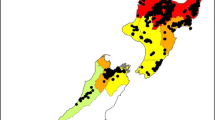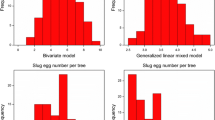Abstract
Pinus patula and high-elevation (HE) sources of P. tecunumanii exhibit intermediate levels of resistance to pitch canker (Fusarium circinatum), compared to extremely resistant species such as P. oocarpa, and extremely susceptible species such as P. radiata. Seedlings from 20 P. patula provenances and 15 HE P. tecunumanii provenances were artificially inoculated with the pitch canker fungus at 21 and 12 weeks of age, respectively, and assessed for resistance 12–20 weeks later. There was important provenance variation in pitch canker resistance for both species. The 20-week LiveStem percentage ranged from 70.3% to 43.6% among the P. patula provenances and 59.6% to 11.7% among HE P. tecunumanii provenances. There was a geographic pattern to the provenance variation, and in both species, low altitude sources demonstrated more resistance than those from high elevation. Provenance variation in pitch canker resistance could be useful when making selection and breeding decisions with these species.

Similar content being viewed by others
References
Balocchi CE (1997) Radiata pine as an exotic species. In: 24th Proc. SFTIC. Orlando, FL. Univ. of Florida, pp 11–17
Birks JS, Barnes RD (1991) Genetic control of wood quality in Pinus patula. Final Report, ODA Research Scheme R4616, Oxford Forestry Institute, University of Oxford, UK. 29 p
Burdon RD (1977) Genetic correlation as a concept for studying genotype-environment interaction in forest tree breeding. Silvae Genet 26:168–175
Dvorak WS (1986) Provenance /progeny testing of Pinus tecunumanii. In: Proc. IUFRO. A joint meeting of working parties on Breeding theory, progeny testing and seed orchards. Oct. 13–17. Williamsburg, VA. North Carolina State University. Raleigh, NC, pp 299–309
Dvorak WS, Raymond RH (1991) The taxonomic status of closely related closed cone pines in Mexico and Central America. New Forests 4:291–307
Dvorak WS, Jordan AP, Hodge GR, Romero JL (2000) Assessing evolutionary relationships in the Oocarpae and Australes subsections using RAPD markers. New Forests 20:163–192
Dvorak WS, Jordan AP, Romero JL, Hodge GR, Furman BJ (2001) Quantifying the geographic range of Pinus patula var. longipedunculata in southern Mexico using morphologic and RAPD marker data. South African Forest J 19:219–30
Dwinell LD, Barrows-Broaddus JB, Kulman EG (1985) Pitch canker: A disease complex of southern pines. Plant Dis 69:270–276
Furman BJ, Dvorak WS, O’Malley DM (1997) Analysis of genetic relationships of Central American and Mexican pines using RAPD markers that distinguish species. Mol Ecol 6(4):321–331
Furman BJ, Dvorak WS (2005) Population level analysis to identify species diagnostic RAPD markers for classification of Central American and Mexican pines. Forest Genet 12:67–78
Grattapaglia D, O’Malley D, Dvorak W (1992) Phylogenetic analysis of Central American and Mexican pines using RAPD markers on bulked DNA samples. In: Proc. IUFRO Resolving Tropical Forest Resource Concerns through Tree Improvement, Gene Conservation and Domestication of New Species. Cartegena and Cali, Colombia, pp 132–147
Gordon TR, Storer AJ, Wood DL (2001) The pitch canker epidemic in California. Plant Dis 85(11):1128–1139
Guerra-Santos J (1999) Pitch canker on Monterey pine in Mexico. In: Devey ME, Matheson AC, Gordon TR (eds) Current and potential impacts of pitch canker in radiata pine. Proc. Impact Monterey Workshop. California, USA, pp 58–61
Hepting GH, Roth ER (1946) Pitch canker, a new disease of some southern pines. J For 44:742–744
Hodge GR, Dvorak WS (1999) Genetic parameters and provenance variation of Pinus tecunumanii in 78 international trials. Forest Genet 6(3):157–180
Hodge GR, Dvorak WS (2000) Differential responses of Central American and Mexican pine species and Pinus radiata to infection by the pitch canker fungus. New Forests 19:241–258
McRae CH, Rockwood DL, Blakeslee GM (1987) Pitch canker resistant Slash pine identified by greenhouse screening. In: Proc. 19th Southern For. Tree Impr. Conf. College Station Texas, June 16–18, pp 132–139
Nirenberg HI, O’Donnell K (1998) New Fusarium species and combinations with the Gibberella fujikuroi species complex. Mycologia 90:434–458
Oak SW, Blakeslee GM, and Rockwood DL (1987) Pitch canker resistant slash pine identified by greenhouse screening. In: Proc. 19th Southern For. Tree Impr. Conf., College Station Texas, June 16–18, pp 132–139
Perry Jr JP (1991) The pines of Mexico and Central America. Timber Press, Inc., Portland, OR, p 231
SAS Institute 1989. SAS/STAT User’s Guide 4th edn., vol 2. SAS Institute, Cary, North Carolina, 846 pp
Vilogen A, Wingfield MJ, Marasas WFO (1994) First report of Fusarium subglutinans f. sp. pini on pine seedlings in South Africa. Plant Dis 78:309–312
Wingfield MJ, Jacobs A, Coutinho TA, Ahumada R, Wingfield BD (2002) First report of the pitch canker fungus, Fusarium circinatum, on pines in Chile. Plant Pathol 51:397
Author information
Authors and Affiliations
Corresponding author
Rights and permissions
About this article
Cite this article
Hodge, G.R., Dvorak, W.S. Variation in pitch canker resistance among provenances of Pinus patula and Pinus tecunumanii from Mexico and Central America. New Forests 33, 193–206 (2007). https://doi.org/10.1007/s11056-006-9023-6
Received:
Accepted:
Published:
Issue Date:
DOI: https://doi.org/10.1007/s11056-006-9023-6




